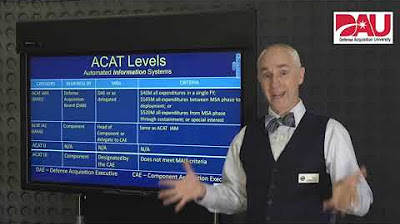Defense Acquisition System Overview
Summary
TLDRMatt Ambrose offers a comprehensive overview of the defense acquisition system, as outlined in DoD Instruction 5000.02. He discusses the five key phases: material solution analysis, technology maturation and risk reduction, engineering and manufacturing development, production and deployment, and operations and support. The talk emphasizes the importance of integrating planning, budgeting, and user requirements to ensure the system operates effectively and efficiently, highlighting the challenges of aligning event-driven, need-driven, and calendar-driven processes.
Takeaways
- 📘 The defense acquisition system is governed by the Department of Defense Instruction 5000.02 and operates in conjunction with planning, programming, budgeting, and execution (PPBE) and the joint capabilities integration and development system (JCIDS).
- 🔄 The acquisition process is event-driven, contrasting with the calendar-driven PPBE and the need-driven JCIDS, creating a challenge to synchronize these different operational paces.
- 🛠️ The system is divided into five phases: Material Solution Analysis, Technology Maturation and Risk Reduction, Engineering and Manufacturing Development, Production and Deployment, and Operations and Support.
- 🔬 Material Solution Analysis involves selecting the most promising technology to meet a user-identified need and establishing a program office with a program manager to oversee the process.
- 🚀 Technology Maturation and Risk Reduction focuses on proving the selected technology through competitive prototyping and systems engineering trade-off analysis to reduce program risks.
- 🏗️ Engineering and Manufacturing Development aims to finalize the system design and establish a product baseline, followed by building prototypes to demonstrate manufacturability and performance.
- 📈 Production and Deployment involves low-rate initial production to validate system performance and manufacturing readiness, leading to a full-rate production decision.
- 🔄 Operations and Support is the final and longest phase, focusing on lifecycle sustainment through performance-based logistics, ensuring system reliability and support throughout its life.
- 💼 Funding is a critical aspect throughout the acquisition process, with full funding required at various milestones to ensure program continuity.
- 📝 Documentation is continuously updated and refined, including the Capability Development Document (CDD) and the Capability Production Document (CPD), which are essential for decision-making and program direction.
- 🗑️ Disposal of the system at the end of its lifecycle is also a planned part of the acquisition process, with considerations for environmental and safety impacts.
Q & A
What is the main topic of the video script?
-The main topic of the video script is an overview of the defense acquisition system as described in the Department of Defense Instruction 5000.2, covering its operation, phases, and interactions with other defense support systems.
Why is interaction with planning, programming, budgeting, and execution (PPBE) and the joint capabilities integration and development system (JCIDS) crucial for the defense acquisition system?
-Interaction with PPBE and JCIDS is crucial because they provide the necessary funding and capability requirements for the defense acquisition system to operate properly. Without a capability need documented by JCIDS and funding from PPBE, a program cannot be initiated or sustained.
What are the five phases of the defense acquisition system mentioned in the script?
-The five phases of the defense acquisition system are: 1) Material Solutions Analysis, 2) Technology Maturation and Risk Reduction, 3) Engineering and Manufacturing Development, 4) Production and Deployment, and 5) Operations and Support.
What is the purpose of the Material Solutions Analysis phase?
-The purpose of the Material Solutions Analysis phase is to select the most promising technology that meets the user's need as expressed in the initial capabilities document and to establish a program office and program manager to oversee the process.
What is the significance of the Technology Maturation and Risk Reduction phase?
-The significance of the Technology Maturation and Risk Reduction phase is to mature the technology and reduce program risks through competitive prototyping, systems engineering, and trade-off analysis, ensuring the technology is feasible and affordable before proceeding to the next phase.
What are the key activities during the Engineering and Manufacturing Development phase?
-The key activities during the Engineering and Manufacturing Development phase include completing a detailed integrated design for the system, conducting a system-level critical design review, establishing a product baseline, and demonstrating manufacturability and performance through building and testing prototypes.
What does the Production and Deployment phase involve?
-The Production and Deployment phase involves low-rate initial production to establish the production base and test the system's performance, followed by full-rate production once the system has been validated through initial operational test and evaluation (IOT&E) and other assessments.
What is the focus of the Operations and Support phase?
-The focus of the Operations and Support phase is to implement a sustainment plan for the system throughout its lifecycle, using performance-based logistics to ensure reliability, quick repairs, and maximized uptime for the warfighter.
How does the defense acquisition system ensure that the technology selected is both affordable and technically feasible?
-The defense acquisition system ensures affordability and technical feasibility through a dialogue with users, trade-off analysis during the Technology Maturation and Risk Reduction phase, and updating the capability development document into a capability production document that reflects lessons learned and refined requirements.
What is the importance of the full funding milestone in the Material Solutions Analysis phase?
-The full funding milestone is important because it secures the necessary budget for the program in the out years, which is crucial for the program's continuation and success. It is a long process due to the annual nature of the budgeting cycle.
How does the script describe the challenge of integrating the event-driven defense acquisition system with the need-driven JCIDS and calendar-driven PPBE?
-The script describes the challenge as making something event-driven work with something need-driven and something calendar-driven, which can be difficult due to their different paces and requirements. This integration is essential for the successful operation of the defense acquisition system.
Outlines

此内容仅限付费用户访问。 请升级后访问。
立即升级Mindmap

此内容仅限付费用户访问。 请升级后访问。
立即升级Keywords

此内容仅限付费用户访问。 请升级后访问。
立即升级Highlights

此内容仅限付费用户访问。 请升级后访问。
立即升级Transcripts

此内容仅限付费用户访问。 请升级后访问。
立即升级5.0 / 5 (0 votes)






